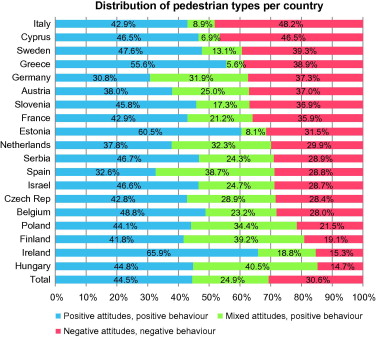
This study aims to identify patterns of pedestrian attitudes, perceptions and behaviour in Europe, on the basis of the results of the SARTRE 4 (Social Attitudes to Road Traffic Risk in Europe) pan-European survey carried out in late 2010 and early 2011 (questionnaire-based personal interviews in 19 European countries involving 4290 pedestrians). The various components of pedestrian attitudes and behaviour (e.g. acceptance of measures and penalties, risk-taking behaviour, perceived level of service, etc.) were determined by means of a Principal Component Analysis (PCA) on 33 variables contained in the survey. Moreover, groups of pedestrians with similar attitudinal and behavioural characteristics were identified by means of a Two Step Cluster Analysis. The results revealed eight components, from which six are associated with pedestrian attitudes and two with pedestrian behaviour and were further analysed for different countries and different age and gender groups. Furthermore, the cluster analysis revealed three types of pedestrians. The first type concerns pedestrians with ‘positive behaviour and positive attitudes’. The second type concerns pedestrians with ‘negative behaviour and negative attitudes’, a group into which male and young pedestrians are over-represented. The third type concerns neutral pedestrians with ‘positive behaviour but mixed attitudes’, a group that presents the largest dispersion between countries and whose proportion defines the dominant type of pedestrian in each country. However, the proportion of the different types of pedestrians in each country does not appear to be associated with pedestrian fatality rates.
| ID | pj66 |
| Manuscript | |
| DOI | |
| Tags | culture, field surveys, pedestrians, statistical modelling |






